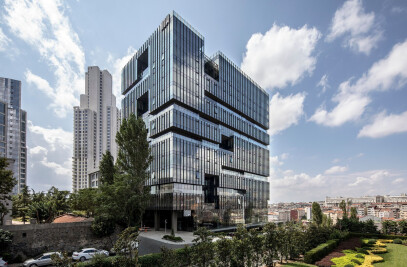LITERARY ASSOCIATIONS Beyazıt State Library is the oldest and the largest library in Istanbul, founded in 1884 as the "Kütüphane-iUmumi-iOsmani". The Library is located in Beyazıt Square, as a part of Beyazıt II Complex adjacent to Beyazıt Mosque - the oldest surviving imperial mosque in the city. The square is connected to the spine of the historical peninsula, Divanyolu, and is one of the most vibrant spaces in the old part of the city.
The restoration of the State Library has involved the sensitive re-organisation of the interior and careful restoration of the building fabric with its prominent multi-domed roof.The State Library was originally the soup kitchen and Caravanserai of a complex that also had a kitchen, a primary school, a hospital, a madrasah and a hammam that spatially surrounds and defines the Beyazıt Square.
The area around the State Library is infused with historical connections of a literary nature. The book bazaar, a courtyard on the site of the Byzantine book and paper store, can be found to the south east of the Mosque and can be entered either from Beyazıt Square or from the Grand Bazaar via the Beyazıt Gate. Early in the Ottoman period printed books were seen as a corrupting influence and were banned in Turkey, so the bazaar sold only manuscripts. The bazaar is still vibrant, within the ebb and flow of the square leading up to the KapalıÇarşı and the Istanbul University. The stone walls of the complex keeps this flow at the bay, offering a place of solitude, well suited to its function.
In place of the former concrete roof, now a light and transparent inflatable membrane structure covers the courtyard, filtering the daylight and providing a controlled atmosphere. In the renovated shell of the building the black glass boxes, devoted to the manuscripts stand as a monolithic object of awe that are of a stark contrast to their surroundings.
Lighting Design, by studio Dinnebier, echoes the spatial and historical qualities of the complex, introducing geometriesin harmony with its surroundings, while the soft lightingat the edges of the raised floor, that follows the wall contours introduce another layer of depth to the spaces.
Programmatically, the complex is introduced with a new layout. Entrance is now through the courtyard. A modest extension, respectful of the scale of the existing building has been added to the northeast façade of the existing Library. Publications in modern Turkish are now located on the 2nd floor, periodicals (in Turkish and Ottoman) are on the 1st floor, and publications in the Ottoman era, manuscripts (in Ottoman, Arabic and Persian) and newspapers are on the Ground Floor.
The restoration of the Beyazıt State Library is exemplary. The ‘minimal intervention’ approach ensures the spirit of the place survives while modern facilities are grafted onto the historic fabric.

































